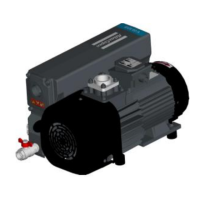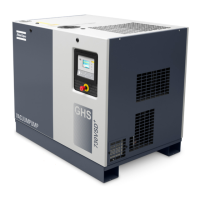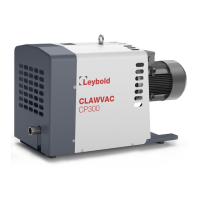2. Use only the correct tools for maintenance and repair work.
3. Use only genuine spare parts.
4. All maintenance work shall only be undertaken when the machine has cooled
down.
5. A warning sign bearing a legend such as "Work in progress; do not start" shall
be attached to the starting equipment.
6. Persons switching on remotely controlled machines shall take adequate
precautions to ensure that there is no one checking or working on the
machine. To this end, a suitable notice shall be affixed to the remote start
equipment.
7. Before removing any component, effectively isolate the machine from all
sources of under- and/or overpressure and make sure that the pump system
is at atmospheric pressure level.
8. Never use flammable solvents or carbon tetrachloride for cleaning parts. Take
safety precautions against toxic vapours of cleaning liquids.
9. Scrupulously observe cleanliness during maintenance and repair. Keep dirt
away by covering the parts and exposed openings with a clean cloth, paper or
tape.
10. Never weld or perform any operation involving heat near the oil system. Oil
tanks must be completely purged, e.g. by steam cleaning, before carrying out
such operations. Never weld on, or in any way modify, pressure vessels.
11. Whenever there is an indication or any suspicion that an internal part of a
machine is overheated, the machine shall be stopped but no inspection
covers shall be opened before sufficient cooling time has elapsed; this to
avoid the risk of spontaneous ignition of the oil vapour when air is admitted.
12. Never use a light source with open flame for inspecting the interior of a
machine, pressure vessel, etc.
13. Make sure that no tools, loose parts or rags are left in or on the machine.
14. All regulating and safety devices shall be maintained with due care to ensure
that they function properly
. They may not be put out of action.
15. Before clearing the machine for use after maintenance or overhaul, check that
operating pressures, temperatures and time settings are correct. Check that
all control and shut-down devices are fitted and that they function correctly. If
removed, check that the coupling guard of the vacuum pump drive shaft has
been reinstalled.
16. Every time the separator element is renewed, examine the discharge and the
inside of the oil separator vessel for carbon deposits; if excessive, the
deposits should be removed.
17. Protect the motor, air filter, electrical and regulating components, etc. to
prevent moisture from entering them, e.g. when steam cleaning.
18. Make sure that all sound damping material and vibration dampers, e.g.
damping material on the bodywork and in the air inlet and outlet systems of
the vacuum pump are in good condition. If damaged, replace it by genuine
material from the manufacturer to prevent the sound pressure level from
increasing.
19. Never use caustic solvents which can damage materials of the air net, e.g.
polycarbonate bowls.
12/2021 - ©Atlas CopcoPage 136996022430_C
Important safety information

